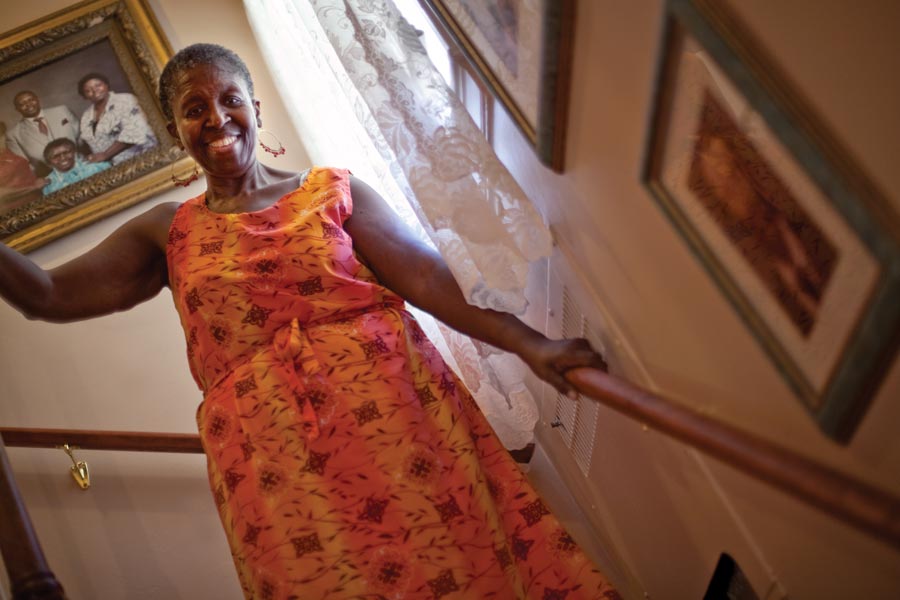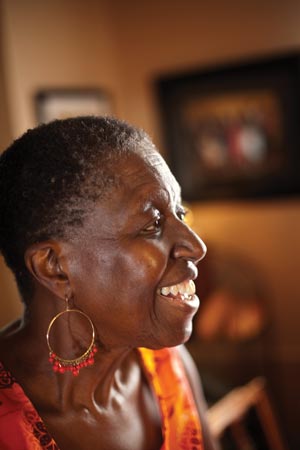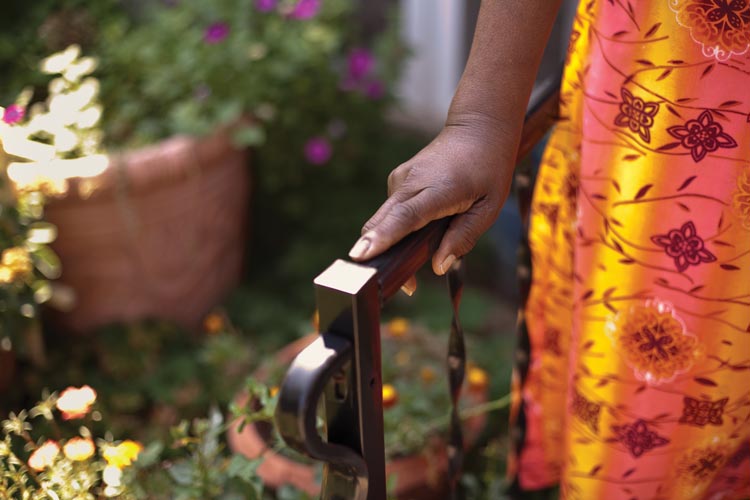With the aid of an unlikely trio – a nurse, an occupational therapist, and a handyman – aging, impoverished Baltimore residents are gaining newfound independence.
by Jennifer Walker
Photos by Chris Hartlove

It used to be difficult for Carol Glover, 68, to get inside the detached garage next to her East Baltimore home. First, she would have to hold on to a wall or the door for support, which required turning her body in uncomfortable and painful ways. Then she used an unsteady brick as a step to navigate the dangerously steep drop down. Glover, who has arthritis and scoliosis, could have easily fallen and been seriously injured.
But on a hot and humid day in August, everything has changed. After opening her garage door, Glover now holds on to a railing to steady herself. The brick has been replaced with a sturdy wooden platform, which she carefully steps on. Her muscles are also stronger now, thanks to weekly tai chi classes. Today Glover can walk into her garage without pain or fear of falling. “[Now] I don’t have to feel timid,” she says, “[and] it’s made a world of difference in my arthritis.”
Glover is one of 42 participants in the CAPABLE (Community Aging in Place: Advancing Better Living for Elders) study, a community outreach research project created by Sarah Szanton, PhD, CRNP, at the Johns Hopkins University School of Nursing. With its pilot year completed, the study has provided dozens of low-income older adults with the resources to age safely in their homes.

While providing house calls to older adults, Szanton learned that their environmental challenges are often as pressing as their health challenges. “Half of the people who have ever lived to be 65 in the history of humans are alive now,” she says. “We have to come up with more cost-effective strategies for aging at home.”
Szanton developed the CAPABLE study to find these strategies. The older adults selected for the study—with the help of the Baltimore City Commission on Aging and Retirement, the Baltimore Housing Authority, and Comprehensive Housing Assistance (CHAI)—were placed in two groups.
The first group had their physical, mental, and environ-mental challenges addressed through three services—occupational therapy, nursing, and the assistance of a construction specialist who made necessary home repairs, while the second group participated in life-review sessions that have been shown to improve mental activity only.
Finding “Me Time”
Glover was one of 25 adults in the first group. In her cozy kitchen, she explains that she first worked with occupational therapist Allysin Bridges, MA, OTR/L. Bridges found environmental problems in Glover’s home, evaluated her ability to complete daily living activities like bathing and dressing, and developed a list of goals with her. One of these goals was for Glover to take time out for herself.
This was a challenging task because Glover has taken care of people most of her life. When she was only seven years old, she rode the bus alone from Baltimore to Washington, DC to help out with her aunt’s kids. As an adult she spent decades teaching children, youth, and adults. And to this day she’s always let people stay in her home.
Glover walks into her living room and stands beneath four framed photographs, one for each generation of her family. She points to her mother, “the oldest rat in the barn,” who has lived with her since having an aortic aneurysm two years ago. Her aunt has Alzheimer’s and lives with her too. “We’re the Golden Girls,” Glover says.

Even with her own health issues, Glover methodically chronicles the needs of her family. On a shelf in her dining room she keeps a yellow folder filled with medical histories, lists of doctors, and photocopies of insurance cards for her mother and her aunt. “My life is very family-centered,” she says. “I have to work at saying ‘no’ and taking time out for me.”
Glover now pencils “Me time” into her calendar and even wrote a memo to loved ones explaining her goal. She has set aside time when she does not take phone calls or receive visitors. Instead, she has “physical and spiritual rejuvenation” time—i.e., saying her daily devotions, exercising, and even occasionally watching TV.
Bridges calls Glover a model client. “[She] never missed a session, and was receptive to input, whether it was a new strategy for reducing stress or a modification to her kitchen…She took the program seriously.” So much so that Glover keeps a laminated copy of her memo on a chest of drawers in her bedroom. This helps her remember her goals.
Lowering the Bar
Near this chest Glover has a closet with rods that were difficult for her to reach. She’s shrunk since moving to the house in 1986, so items like the closet bars and the microwave, which sits on a shelf above the kitchen table, have become too high. “It’s dangerous,” she says about the microwave, “because you’re putting stuff in hot and taking it down.”
For the second component of the CAPABLE program, construction specialists from Civic Works, Baltimore’s urban service corps, came to Glover’s home to repair problems that were making it hard for her to remain independent. For example, they lowered the rods and the microwave shelf.
They also made it safer for Glover to walk up the stairs that lead to the second floor. Glover says she used to lean on the left banister for support, putting all of her weight on one side as she walked. So Civic Works installed a second banister on the right to help with her balance. “I didn’t even know I needed it until they told me,” she says as she walks up the steps, alternating her weight from her left to her right side. “And I really do.”
Living with Less Pain
For the third and final component of the program, Glover met with Jill Roth, RN, who addressed participants’ issues such as pain management, depression, and medication adherence. According to Roth, research shows a person on five or more medications has an increased risk of falling. Glover was on about 20 medications. So Roth suggested other ways to alleviate her pain like using warm compresses, and a cream with cayenne pepper, that helps with arthritis.
Glover found her favorite activity was tai chi. “[Tai chi] helps me move around; it’s strengthening my thighs and hips; it helps with my breathing.” She can also practice it all day long. While making dinner or washing dishes, she twists her hips left and right in slow, controlled motions. In church, she places one foot in front of the other and rocks her weight forward then back. And she practices breathing from her belly “just like a baby does,” which brings more air into her lungs.
“Tai chi had the most profound effect on her,” Roth says. “After six months, I could see that her posture had changed, and she was saying that she was in very little pain.”
A CAPABLE Future
For Glover, it was Roth and the rest of the CAPABLE staff that made the study a success. “I’m a people person, so I look at how people relate to you…to me, they went beyond what they had to do.”
Szanton says that early results for everyone in Glover’s group are promising: they had much less difficulty completing daily living tasks such as bathing, dressing, preparing meals, using the telephone, and doing housework, and they showed a 24 percent improvement in their lower extremity function. She is currently applying for funding to verify and enlarge her results with 300 older adults in Baltimore City.
When she’s ready to find more participants, Glover can help. “I’ve told all my senior relatives and friends about the program and they said, ‘Oh, how can I get in it?’” she says. “I’ve got plenty of [names].”
For more information, visit www.nursing.jhu.edu/capable
Captions:
Carol Glover, 68, is enjoying a healthier, more independent life thanks to a Hopkins nursing study.
Newly installed railings and banisters help Glover around her home.